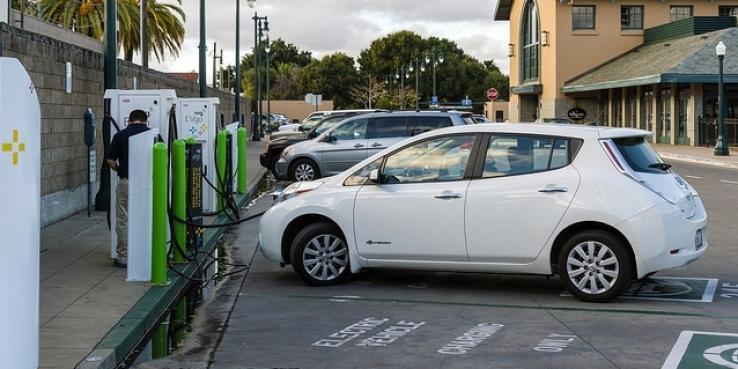At SPUR we spend a lot of time promoting urban design, transit service and infrastructure that help people get around without requiring everyone to own and drive cars every day. But we also recognize that there will always be some amount of driving, and that we need clear plans and policies for cars, too. After all, passenger cars are the single largest source of greenhouse gas emissions in our state and region, and they directly generate pollution that harms human health. Because of this, SPUR has advocated for policies that will move us toward a future where more and more new cars are electric. As our electricity sources become increasingly renewable, electric vehicles (EVs) will be powered more and more by sources like wind and solar.
A recent EV event hosted by the Center for Sustainable Energy (CSE) gave an update on how the EV transition is progressing. Moderated by the San Francisco Department of the Environment — with panelists from CSE, the California Capital Access Program (CalCAP) and Pacific Gas and Electric (PG&E) — the event covered current market trends and policies in EVs and charging infrastructure. The panelists also showcased powerful tools for planning and financing EV chargers at small businesses and multi-unit dwellings — places typically underserved in the existing market and crucial to greater and more equitable EV adoption in our region.
The panelists shared four key takeaways on how the Bay Area is moving forward:
- The Bay Area leads the nation in clean vehicle and EV adoption. Of the more than 500,000 zero-emission vehicles sold to date in the United States, half were bought in California and almost 20 percent were bought in the Bay Area alone. (Zero emission vehicles include battery electric, extended range plug-in hybrids and hydrogen fuel cell vehicles.) The San Jose and San Francisco metro areas lead the nation in both the shares of EVs on their roads and the number of per capita EV chargers installed.
- Policy leadership is propelling our EV success. The state’s Zero-Emission Vehicle program ensures a steady supply of EVs, as nearly a quarter of vehicles sold in the state by 2025 must emit no pollution. Automakers are taking this opportunity to make EVs that steal the spotlight, like the new Chevy Bolt that goes 238 miles on a single charge and costs under $28,000 after rebates, or Tesla’s Model 3 with similar expected specs and 400,000 pre-orders.
In addition, recent state law allows our biggest utilities, including PG&E, to become major transportation fuel providers. To this end, PG&E plans to build out 7,500 charging sites across northern California in the next handful of years.
- As the EV market matures from early adopters to mainstream buyers, continued rebates for EVs and greater access to charging is important. Surveys of California EV buyers show that over time the state’s Clean Vehicle Rebates have become more central in the decision to buy an EV. This means that current buyers are more sensitive to cost and likely lower-income than early adopters. (According to decision factors on the California Vehicle Revote Program’s EV Consumer Dashboard, fuel savings is the deciding factor for EV buyers.) Continuing rebates could prove crucial in making EVs possible at all income levels.
Also, the vast majority of EV charging is currently happening in single-family homes where it’s easy to install a charger using wiring or outlets typical for an electric clothes dryer. On the other hand, installing chargers in multi-tenant buildings is often complicated by a lack of clarity around who should pay for and manage a charger in a semi-public space. Increasing charging options for drivers living in multi-unit buildings could prove instrumental in the next wave of EV adoption and in bringing low-emission vehicles to low-income neighborhoods.
- There are many tools for planning and financing chargers in the places we need them. PG&E has committed to installing chargers in disadvantaged communities and multi-unit dwellings, but the exact sites have not been chosen. This means there’s an opportunity to get these locations right. PG&E is looking for advice on its future charger sites and you can suggest one.
Building managers, employers and condo owners can also take the lead. CSE offers guides on how to site chargers, who should own and maintain them, how to manage public access and more (see here and here for guides). Low-cost financing for charger installation is also available to small businesses, nonprofits and multi-unit building managers through the CalCAP Electric Vehicle Charging Station program, helping to make installations possible in hard-to-reach locations.
The transition to wider use of EVs by a greater diversity of drivers can help provide a more stable climate, better local air quality and greater equity in our communities. We hope resources like the ones mentioned here will speed adoption in the months and years to come.
Read SPUR’s policy recommendations for EVs in our report Fossil Free Bay Area >>
